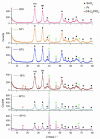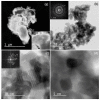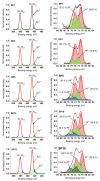Microwave-Assisted Synthesis of Pt/SnO2 for the Catalytic Reduction of 4-Nitrophenol to 4-Aminophenol
- PMID: 37686989
- PMCID: PMC10489642
- DOI: 10.3390/nano13172481
Microwave-Assisted Synthesis of Pt/SnO2 for the Catalytic Reduction of 4-Nitrophenol to 4-Aminophenol
Abstract
In this study, we present a new approach for the synthesis of Pt/SnO2 catalysts using microwave radiation. Pt(IV) and Sn(IV) inorganic precursors (H2PtCl6 and SnCl4) and ammonia were used, which allowed the controlled formation of platinum particles on the anisotropic SnO2 support. The synthesized Pt/SnO2 samples are mesoporous and exhibit a reversible physisorption isotherm of type IV. The XRD patterns confirmed the presence of platinum maxima in all Pt/SnO2 samples. The Williamson-Hall diagram showed SnO2 anisotropy with crystallite sizes of ~10 nm along the c-axis (< 00l >) and ~5 nm along the a-axis (< h00 >). SEM analysis revealed anisotropic, urchin-like SnO2 particles. XPS results indicated relatively low average oxidation states of platinum, close to Pt metal. 119Sn Mössbauer spectroscopy indicated electronic interactions between Pt and SnO2 particles. The synthesized samples were used for the catalytic reduction of 4-nitrophenol (4-NP) to 4-aminophenol (4-AP) in the presence of excess NaBH4. The catalytic activity of the Pt/SnO2 samples for the reduction of 4-NP to 4-AP was optimized by varying the synthesis parameters and Pt loading. The optimal platinum loading for the reduction of 4-NP to 4-AP on the anisotropic SnO2 support is 5 mol% with an apparent rate constant k = 0.59 × 10-2 s-1. The Pt/SnO2 sample showed exceptional reusability and retained an efficiency of 81.4% after ten cycles.
Keywords: 119Sn Mössbauer; 4-nitrophenol; SnO2; XPS; catalyst; microwave synthesis; platinum.
Conflict of interest statement
The authors declare no conflict of interest. The funders had no role in the design of the study; in the collection, analyses, or interpretation of data; in the writing of the manuscript; or in the decision to publish the results.
Figures













Similar articles
-
Catalytically Active Oxidized PtOx Species on SnO2 Supports Synthesized via Anion Exchange Reaction for 4-Nitrophenol Reduction.Nanomaterials (Basel). 2025 Jul 28;15(15):1159. doi: 10.3390/nano15151159. Nanomaterials (Basel). 2025. PMID: 40801699 Free PMC article.
-
One-Pot Green Synthesis of Ag-Decorated SnO2 Microsphere: an Efficient and Reusable Catalyst for Reduction of 4-Nitrophenol.Nanoscale Res Lett. 2017 Dec;12(1):435. doi: 10.1186/s11671-017-2204-8. Epub 2017 Jun 30. Nanoscale Res Lett. 2017. PMID: 28673053 Free PMC article.
-
Carbon nanotubes/tin oxide nanocomposite-supported Pt catalysts for methanol electro-oxidation.J Colloid Interface Sci. 2015 Jul 15;450:74-81. doi: 10.1016/j.jcis.2015.02.072. Epub 2015 Mar 12. J Colloid Interface Sci. 2015. PMID: 25801135
-
Pt-Based Catalysts for Electrochemical Oxidation of Ethanol.Top Curr Chem (Cham). 2019 Apr 4;377(3):11. doi: 10.1007/s41061-019-0236-5. Top Curr Chem (Cham). 2019. PMID: 30949779 Review.
-
Reduction of 4-nitrophenol using green-fabricated metal nanoparticles.RSC Adv. 2022 Jun 24;12(29):18661-18675. doi: 10.1039/d2ra02663e. eCollection 2022 Jun 22. RSC Adv. 2022. PMID: 35873318 Free PMC article. Review.
Cited by
-
Emulsion Liquid Membranes Based on Os-NP/n-Decanol or n-Dodecanol Nanodispersions for p-Nitrophenol Reduction.Molecules. 2024 Apr 18;29(8):1842. doi: 10.3390/molecules29081842. Molecules. 2024. PMID: 38675662 Free PMC article.
-
Catalytically Active Oxidized PtOx Species on SnO2 Supports Synthesized via Anion Exchange Reaction for 4-Nitrophenol Reduction.Nanomaterials (Basel). 2025 Jul 28;15(15):1159. doi: 10.3390/nano15151159. Nanomaterials (Basel). 2025. PMID: 40801699 Free PMC article.
References
-
- Papandrew A.B., Chisholm C.R.I., Elgammal R.A., Özer M.M., Zecevic S.K. Advanced Electrodes for Solid Acid Fuel Cells by Platinum Deposition on CsH2PO4. Chem. Mater. 2011;23:1659–1667. doi: 10.1021/cm101147y. - DOI
-
- Liu D., Li X., Chen S., Yan H., Wang C., Wu C., Haleem Y.A., Duan S., Lu J., Ge B., et al. Atomically dispersed platinum supported on curved carbon supports for efficient electrocatalytic hydrogen evolution. Nat. Energy. 2019;4:512–518. doi: 10.1038/s41560-019-0402-6. - DOI
-
- Haneda M., Watanabe T., Kamiuchi N., Ozawa M. Effect of platinum dispersion on the catalytic activity of Pt/Al2O3 for the oxidation of carbon monoxide and propene. Appl. Catal. 2013;142:8–14. doi: 10.1016/j.apcatb.2013.04.055. - DOI
Grants and funding
LinkOut - more resources
Full Text Sources
Miscellaneous

